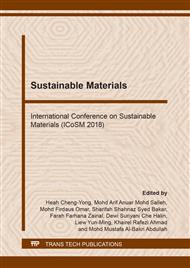[1]
A. F. Hamzah, M. H. Wan Ibrahim, N. Jamaluddin, R. Putra Jaya, M. Fadzil, N. E. Zainal Abidin, E. Abd Manan and N. A. Omar, Nomograph of Self Compacting Concrete Incorporating Coal Bottom Ashas Partial Replacement of Fine Aggregate,, Journal of Engineering and Applied Sciences, vol. 11, no. 7, 2016, pp.1671-1675.
DOI: 10.4028/www.scientific.net/amm.773-774.916
Google Scholar
[2]
M. Kushwaha, S. Akhtar, and S. Rajput, Development of the Self Compacting Concrete By Industrial Waste (Red Mud),, International Journal of Engineering Research and Applications, vol. 3, no. 4, 2013, p.539–542.
Google Scholar
[3]
A. R. M. Ridzuan, M. A. M. Fauzi and K. Azman, The Evaluation of Self Consolidating Concrete Incorporating Crushed Concrete Waste Aggregate,, 3rd International Symposium & Exhibition in Sustainable Energy & Environment (ISESEE 2011), 1-3 June 2011, Melaka, Malaysia., pp.100-105.
DOI: 10.1109/isesee.2011.5977118
Google Scholar
[4]
P. Helincks, V. Boel, W. De Corte, G. De Schutter, and P. Desnerck, Structural behaviour of powder type self-compacting concrete: bond performance and shear capacity,, Engineering Structures Journal, vol. 48, 2013, pp.121-132.
DOI: 10.1016/j.engstruct.2012.08.035
Google Scholar
[5]
C. Shi, Z. Wu, K. Lv, and L. Wu, A review on mixture design methods for self-compacting concrete,, Construction and Building Materials Journal, vol.84, 2015, p.387–398.
DOI: 10.1016/j.conbuildmat.2015.03.079
Google Scholar
[6]
A. A. Hilal, N. H. Thom, and A. R. Dawson, On void structure and strength of foamed concrete made without/with additives,, Construction and Building Materials Journal, vol. 85, 2015, p.157–164.
DOI: 10.1016/j.conbuildmat.2015.03.093
Google Scholar
[7]
K. H. Yang, K. H. Lee, J. K. Song, and M. H. Gong, Properties and sustainability of alkali-activated slag foamed concrete,, Journal of Cleaner Production, vol. 68, 2014, p.226–233.
DOI: 10.1016/j.jclepro.2013.12.068
Google Scholar
[8]
A. A. Sayadi, T.J. Vilches, T. R. Neitzert, and G. C. Clifton, Effectiveness of foamed concrete density and locking patterns on bond strength of galvanized strip,, Construction and Building Materials Journal, vol. 115, 2016, p.221–229.
DOI: 10.1016/j.conbuildmat.2016.04.047
Google Scholar
[9]
E. Kuzielova, L. Pach, and M. Palou, Effect of activated foaming agent on the foam concrete properties,, Construction and Building Materials Journal, vol. 125, 2016, p.998–1004.
DOI: 10.1016/j.conbuildmat.2016.08.122
Google Scholar
[10]
D. L. Y. Kong and J. G. Sanjayan, Damage behavior of geopolymer composites exposed to elevated temperatures,, Cement and Concrete Composites Journal, vol. 30, 2008, pp.986-991.
DOI: 10.1016/j.cemconcomp.2008.08.001
Google Scholar
[11]
V. M. Malhotra, Introduction: Sustainable Development and Concrete Technology,, Concrete International, vol. 24, 2002, p.22.
Google Scholar
[12]
G. A. Habeeb and H. B. Mahmud, Pozzolans for Sustainable Concrete - A Review," International Conference for Technical Postgraduate (TECHNOS), "Towards Advancement of Engineering Research - Global Challenges,. (2009).
Google Scholar
[13]
N. M. Altwair and S. Kabir, Green concrete structures by replacing cement with pozzolanic materials to reduce greenhouse gas emissions for sustainable environment," 6th International Engineering and Construction Conference (IECC,6). (2010).
Google Scholar
[14]
L. Antoni Chandra and D. Hardjito, The impact of using fly ash, silica fume and calcium carbonate on the workability and compressive strength of mortar,, Procedia Engineering, vol. 125, 2015, p.773.
DOI: 10.1016/j.proeng.2015.11.132
Google Scholar
[15]
EFNARC. The European Guidelines for Self-Compacting Concrete,, (May 2005), 63. Retrieved from http://www.efnarc.org/pdf/SCCGuidelinesMay2005.pdf.
Google Scholar
[16]
C. H. Aginam, S. N. Umenwaliri and C. Nwakire, Influence of mix design methods on the compressive strength of concrete,, Progress in Energy Combustion science ARPN Journal of Engineering and Applied Sciences, vol. 8, no. 6, 2013, pp.438-444.
Google Scholar
[17]
BS EN 12390-2:2009 Testing Hardened Concrete. Making And Curing Specimens For Strength Tests,, British Standard, 2009, pp.1-12.
Google Scholar
[18]
BS EN 206- 9: 2010, Concrete. Additional Rules for Self Compacting Concrete (SCC),, British Standard, 2010, pp.1-16.
Google Scholar
[19]
BS EN 12390-3: 2009, Testing Hardened Concrete. Compressive Strength Of Test Specimens,, British Standard, 2009, pp.1-22.
Google Scholar
[20]
W. M. S. Supit and U. A. F. Shaikh, Effect of Nano-CaCO3 on Compressive Strength Development of High Volume Fly Ash Mortars and Concretes,, Journal of Advanced Concrete Technology, vol. 12, No. 6, 2014, p.178–186.
DOI: 10.3151/jact.12.178
Google Scholar
[21]
P. Lertwattanaruk, S. Gritsada and M. Natt, Effects of calcium carbonate powder on the fresh and hardened properties of self-consolidating concrete incorporating untreated rice hush ash,, Journal of Cleaner Production, vol. 172, 2018, pp.3265-3278.
DOI: 10.1016/j.jclepro.2017.10.336
Google Scholar
[22]
H. Zhao, W. Sun, X. Wu and B. Gao, The effect of coarse aggregate gradation on the properties of self-compacting concrete,, Materials and Design Journal, vol. 40, 2012, p.109–116.
DOI: 10.1016/j.matdes.2012.03.035
Google Scholar
[23]
A. R. M. Ridzuan and M. A. M. Fauzi, Strength assessment of self consolidating concrete incorporating supplementary cementitious material and crushed concrete waste aggregate,, International Sustainability and Civil Engineering Journal, vol. 1, no. 1, 2012, pp.67-74.
DOI: 10.1109/isesee.2011.5977118
Google Scholar


